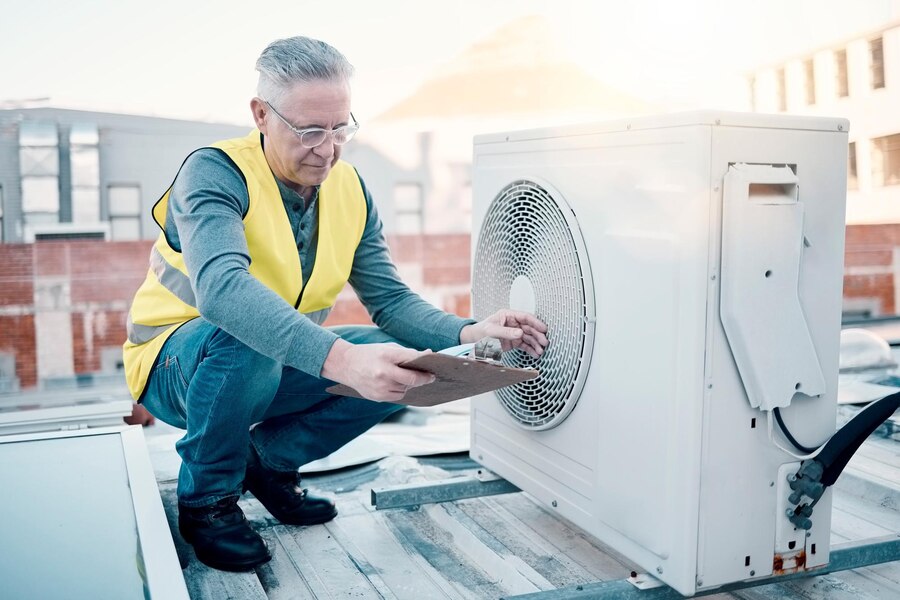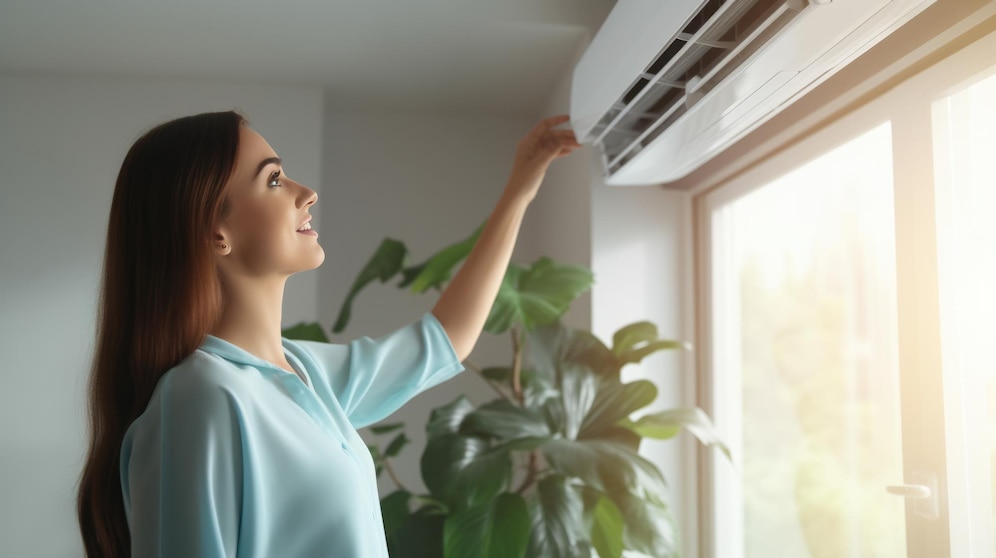As the temperatures soar in Stanton, California, air conditioning becomes not just a luxury but a necessity for staying comfortable and productive. But beyond the refreshing blast of cool air, have you ever paused to ponder how exactly air conditioning achieves this feat?
In this comprehensive exploration, we’ll dive into the intricate mechanics that underpin air conditioning systems, shedding light on the fascinating science that keeps your indoor environment at an optimal temperature, even when the mercury climbs to unbearable heights. With expertise from Tradewind HVAC, we’ll uncover the inner workings of these systems and explore how they contribute to your comfort and well-being in Orange, California.
Heating and Air Conditioning Services
Role of refrigerants in the cooling process
Central to the functionality of any air conditioning system is the pivotal role played by refrigerants. These specialized chemicals possess a unique property: they have the remarkable ability to absorb and release heat, which is fundamental to the cooling process. Let’s delve deeper into how refrigerants facilitate the transformation of hot, stuffy air into a refreshingly cool indoor oasis.
As the heart of the air conditioning system, refrigerants circulate through a closed-loop network of coils and components. Their journey begins within the evaporator coil, located indoors, where they encounter warm indoor air drawn from your living or working space. Here, the refrigerant undergoes a phase change, transitioning from a liquid to a gaseous state as it absorbs heat energy from the surrounding air.
With its newfound load of heat energy, the refrigerant is then pumped to the outdoor unit, typically known as the condenser unit. Here, the refrigerant encounters a compressor, which increases its pressure and temperature, transforming it back into a high-pressure liquid. As the refrigerant flows through the condenser coil, situated outdoors, it releases the absorbed heat energy into the surrounding environment.
Functionality of key components like compressors and evaporators
In the intricate machinery of an air conditioning system, compressors and evaporators stand as vital components, each playing a distinct yet interconnected role in the cooling process. Let’s delve into the functionality of these key components and how they collaborate to keep your indoor environment refreshingly cool and comfortable.
- Compressor: The compressor serves as the heart of the air conditioning system, responsible for pressurizing the refrigerant and facilitating its circulation through the system. Operating within the outdoor unit, the compressor receives low-pressure, low-temperature refrigerant vapor from the evaporator coil. Its primary function is to increase the pressure and temperature of the refrigerant, transforming it into a high-pressure, high-temperature gas.
By compressing the refrigerant, the compressor enables it to release the absorbed heat energy more efficiently when it reaches the condenser coil. This pressurized refrigerant gas is then pumped through the condenser coil, where it undergoes condensation and releases the absorbed heat energy into the outdoor air. As a result, the refrigerant transitions back into a liquid state, ready to repeat the cooling cycle.
- Evaporator: On the other hand, the evaporator coil functions as the site where the actual cooling process takes place. Located within the indoor unit of the air conditioning system, the evaporator coil plays a crucial role in absorbing heat from the indoor air and facilitating its transfer to the refrigerant.
As warm indoor air is drawn over the evaporator coil, the low-pressure, low-temperature refrigerant circulating within the coil absorbs heat energy from the air, causing it to evaporate and transition into a gas. This phase change results in a significant drop in temperature, effectively cooling the air passing over the coil.
Once the indoor air has been cooled and dehumidified by the evaporator coil, it is then distributed throughout the indoor space via the ductwork, providing a comfortable and refreshing environment for occupants.

Importance of airflow and ventilation
In the realm of air conditioning, airflow and ventilation play integral roles in maintaining optimal indoor comfort and air quality. Beyond simply cooling the air, ensuring proper airflow and ventilation is essential for achieving a truly comfortable and healthy indoor environment. Let’s delve into why these factors are crucial for the effectiveness and efficiency of your air conditioning system.
First and foremost, proper airflow is essential for ensuring that the cool air produced by your air conditioning system is evenly distributed throughout the space. Without adequate airflow, certain areas of your home or office may remain uncomfortably warm while others enjoy the desired level of cooling. This imbalance can lead to hot spots, discomfort, and even potential strain on the air conditioning system as it struggles to compensate for the uneven distribution of air.
Moreover, effective ventilation is equally important for maintaining indoor air quality and promoting a healthy living or working environment. Ventilation systems help to remove stale air, pollutants, and odors from indoor spaces, replacing them with fresh outdoor air. This continuous exchange of air not only prevents the buildup of harmful contaminants but also helps to regulate humidity levels, reducing the risk of mold and mildew growth.
By optimizing airflow and ventilation within your home or office, you can maximize the efficiency and effectiveness of your air conditioning system. Proper airflow ensures that cool air reaches every corner of the space, eliminating hot spots and providing consistent comfort throughout. Additionally, effective ventilation helps to remove indoor pollutants and maintain a fresh, clean indoor environment, promoting both comfort and health.
Energy efficiency considerations in AC operation
Energy efficiency stands as a paramount consideration in the operation of any air conditioning system, offering not only cost savings but also environmental benefits. Let’s explore some key factors to consider in maximizing the energy efficiency of your AC system:
- Selection of High-Efficiency Units: When purchasing an air conditioning system, opt for models with high Energy Efficiency Ratio (EER) or Seasonal Energy Efficiency Ratio (SEER) ratings. These ratings indicate the efficiency of the unit in converting electrical energy into cooling output. Choosing a higher-rated unit may involve a higher upfront cost, but it pays off in the long run through reduced energy consumption and lower utility bills.
- Regular Maintenance: Proper maintenance is essential for optimizing the efficiency and longevity of your air conditioning system. Schedule regular inspections and tune-ups by a qualified HVAC technician to ensure that all components are functioning at peak performance. Tasks such as cleaning coils, lubricating moving parts, and checking refrigerant levels can significantly improve efficiency and prevent costly breakdowns.
- Clean Air Filters: Dirty or clogged air filters restrict airflow, forcing the AC system to work harder to maintain desired indoor temperatures. Replace or clean air filters regularly, according to the manufacturer’s recommendations, to ensure unrestricted airflow and efficient operation. This simple maintenance task can improve energy efficiency and prolong the lifespan of your system.
- Proper Insulation and Sealing: Ensure that your home or office is adequately insulated and properly sealed to minimize heat gain in summer months. Seal any gaps or leaks in windows, doors, and ductwork to prevent conditioned air from escaping and hot outdoor air from entering. By reducing air leakage, you can maintain a more consistent indoor temperature and lessen the workload on your air conditioning system.
- Utilize Programmable Thermostats: Install programmable thermostats to regulate indoor temperatures according to your schedule. Set higher temperatures when the space is unoccupied or during sleeping hours to reduce energy consumption. Programmable thermostats allow for precise temperature control and can help optimize energy usage without sacrificing comfort.
The Science Behind Air Conditioning at Tadewind HVAC
The mechanics behind air conditioning systems are a fascinating interplay of various components and processes aimed at keeping indoor environments cool and comfortable, particularly in places like Stanton, California, where high temperatures are common. Refrigerants play a crucial role in absorbing and releasing heat, with compressors and evaporators acting as key components in the cooling process.
Proper airflow and ventilation are essential for distributing cool air evenly and maintaining indoor air quality, while energy efficiency considerations, such as selecting high-efficiency units, regular maintenance, clean air filters, proper insulation and sealing, and utilizing programmable thermostats, are vital for minimizing energy consumption and environmental impact. Contact us today for expert advice on optimizing your HVAC system for efficiency and comfort.

FAQs
- What role do refrigerants play in the cooling process of air conditioning systems?
- Refrigerants absorb and release heat, facilitating the transformation of warm indoor air into cool air within the system.
- How do key components like compressors and evaporators function in air conditioning systems?
- Compressors increase the pressure and temperature of refrigerants, while evaporators absorb heat from indoor air, cooling it down before distribution.
- Why is airflow important in air conditioning systems?
- Proper airflow ensures even distribution of cool air throughout indoor spaces, eliminating hot spots and improving comfort levels.
- What is the significance of ventilation in maintaining indoor air quality?
- Ventilation systems remove pollutants and odors from indoor spaces, replacing them with fresh outdoor air to promote a healthy environment.
- How can homeowners optimize the energy efficiency of their air conditioning systems?
- Homeowners can maximize energy efficiency by selecting high-efficiency units, scheduling regular maintenance, cleaning air filters, ensuring proper insulation and sealing, and utilizing programmable thermostats.
- What are some signs that indicate an air conditioning system needs repair?
- Signs include strange noises, uneven heating or cooling, increased energy bills, frequent cycling, and leaks or moisture around the unit.
- Why is it important to address strange noises coming from an HVAC system promptly?
- Addressing strange noises promptly can prevent further damage to the system and potentially costly repairs in the future.
- How can homeowners maintain optimal indoor comfort and air quality during hot weather?
- Homeowners can maintain optimal comfort and air quality by ensuring proper airflow, ventilation, and energy efficiency in their air conditioning systems.
- What are some energy-efficient practices homeowners can adopt to reduce their cooling costs?
- Energy-efficient practices include setting higher temperatures when spaces are unoccupied, scheduling regular maintenance, and ensuring proper insulation and sealing.
-
How does Tadewind HVAC specialize in optimizing air conditioning systems for efficiency and comfort?
- Tadewind HVAC offers expert advice and services to optimize air conditioning systems for efficiency and comfort, particularly in areas like Stanton, California, where high temperatures are common.

